Moira Butterfield's Blog, page 23
January 12, 2020
Ten Top Picture Book Writing Tips • Lynne Garner
 I don't list the colours in the jumper,
I don't list the colours in the jumper,the illustration shows us. I look back at my career and ask myself "how did I manage to get published?" I knew nothing about plot construction, creating characters children could relate to, how many pages a picture books contains etc. Yet I managed to become a published author. But if I knew then what I know now my journey would have been a shorter one. So, to reduce the length of your journey here are my top ten tips for writing a story an editor will hopefully want to publish. One:Read and learn from picture books. Look at how the story has been constructed, what types of words have been used, what words have been omitted thus allowing the illustrations to also tell the story.
Two:A picture book writer can learn a lot from studying poetry. I’m not suggesting write an entire book in rhyme but there are elements of poetry you can use to improve your story for example the rhythm of the words you choose use.
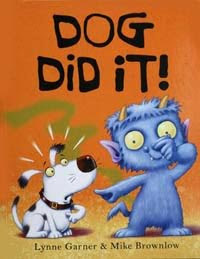 I used long funny words and also repeated
I used long funny words and also repeated phrases to create a rhythm.Three:Explore the use of words. Don’t be afraid to make up them up or use words that are long. For example, one of my nephews favourite picture books featured a T-rex. He loved it when it came to his turn to read the word and always shouted REX at the top of his voice, which was then followed by giggling.
Four:Listen to how children speak, what they talk about, the worries them etc. All of this can be used to fuel your work and ensure you’re writing stories children will enjoy and can relate to.
Five:Break down your story into spreads and think of them as scenes in a play. Ask yourself is there something new happening on every page? Have you given the illustrator enough to work with? Does the new scene move the story forward? If the answer to any of these is no then you need to have a rethink.
Six:
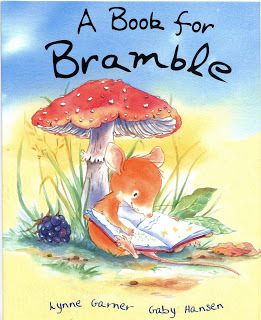 Teasel and Brambles tell us how they feel
Teasel and Brambles tell us how they feelin their own words and by their actions.Let your characters tell the story in their own words. Let them show the reader what they are feeling and thinking.
Nine:Everyone loves to laugh, so if appropriate include a little humour. Either use words or provide the illustrator with notes, so the humour can be shown in the illustrations.
Ten:Have a go at using the magic number three in your story. Have you ever read The Gruffalo? When the mouse is explaining what the Gruffalo looks like it’s always in threes. Also, there are three animals chasing the mouse. The snake, the fox and the owl. This isn’t new think about the three bears, the three pigs, the three billy goats.
I hope these tips help and good luck with your writing and if you have any other tips please share below or tweet us @picturebookden
Published on January 12, 2020 22:00
January 5, 2020
New Year Resolutions by Chitra Soundar
It's 2020, the start of a new decade. For the first post of the year, I wanted to start with celebrating the New Year.

A new decade and a new year not only brings on a new calendar, a new blank diary to write in but also new year resolutions. We all make them; we all break them. Some we forget, some we abandon and perhaps the hope is one of them will stick.

In that context of making new resolutions, I’ve been looking at picture books that help children form good habits and break bad ones. Gone are the days when children’s books were didactic and full of rules and crazy consequences full of warnings. As this book of Victorian verse will attest to, children were told what not to do and the dire consequences of breaking rules.
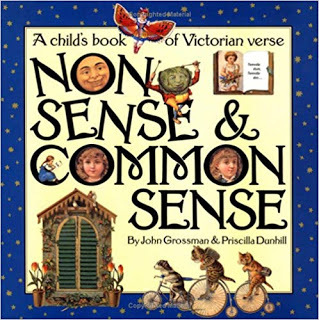
Modern picture books especially those published in the last decade we have just bid goodbye to, has creative approaches to teaching children form good habits. A word of caution for all writers, I learnt early on in my writing career - keep it fun and be conscious of the creeping adult voice full of judgement.
Here are some examples of how to do that.
In this book, Mo Willems highlights the universal angst of all parents and children – bedtime. Children want to have parties, read more stories, dance their night away while parents are tired and frustrated.
 How about eating habits? Some children won’t eat squishy tomatoes and others wouldn’t eat peas. Some won’t eat fruits and some wouldn’t touch an egg for any reason. Charlie has a wonderful idea to make Lola eat her tomato when she cries I will never not ever eat a tomato.
How about eating habits? Some children won’t eat squishy tomatoes and others wouldn’t eat peas. Some won’t eat fruits and some wouldn’t touch an egg for any reason. Charlie has a wonderful idea to make Lola eat her tomato when she cries I will never not ever eat a tomato.
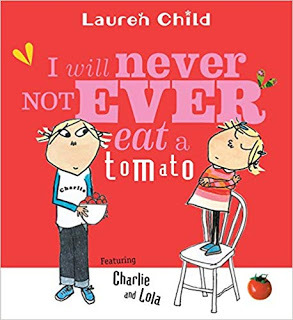
The third most important thing to a child - being active. Some children are readers, some are jumpers and some are holler-yollers. Often their activity levels are exact opposites to their parents. When parents want to rest, children want to play and vice versa. Isn't that a fantastic writing opportunity - in-built conflict and lot of relatable situations.
However, if you wanted to introduce children to start off with a wonderful habit of doing yoga, here is a book that shows how to learn simple postures. Perhaps it’s a parent and child habit-forming book. Was yoga in your resolution for this year? I'm thinking of adding yoga to mine.
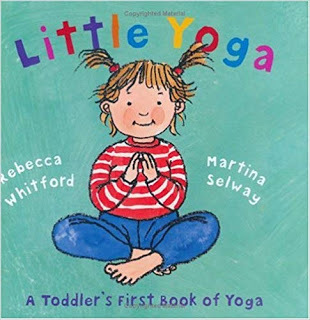
The trouble with telling children what to do is we don’t always follow our own rules. So we preach without practicing – go to bed early, no TV, eat your veg or don’t pick your nose. Children are observant. They know when parents break rules and that make children push that envelope of rebellion a bit more. Here is Daisy telling her mum, why giving advice is easy and following it might not be so.
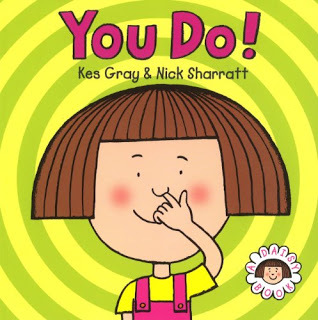
As a picture book writer, these books inspire me to think about different things to write about. (Notice all the underlined phrases in this post.) Children struggle with forming habits as much as adults do. Sometimes it’s about being consistent, sometimes it’s in the follow-through. Are you inspired to write a fun story for children that introduces the concept of making habits – good ones and fun ones? Here is an inspiring activity to start you off.Brian Moses introduced a classroom activity on 2nd Jan that children might love to do – maybe this will inspire you to write funny picture books about funny (or maybe even serious and important ) resolutions. Did you make a resolution for the new year? Can you think of a funny one for adults and one for a young person? Here is my example:Grown-up: I’ll go to bed before midnight - but it's always before midnight in some country, aint it?Child: I’ll never eat a snail when its head is out. Ugh!
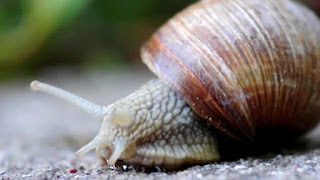
Add yours in the comments section or tweet it to us @picturebookden
 Chitra Soundar is an internationally published author of over 40 books for children. Her books have been published in the UK, US, India, Singapore and translated into German, French, Japanese and Thai. Her picture books have been included in the White Ravens Catalogue, IBBY International Books of USA, the prestigious Bank Street Bookstore lists and have been shortlisted for many awards. Find out more at www.chitrasoundar.com and follow her on twitter at @csoundar.
Chitra Soundar is an internationally published author of over 40 books for children. Her books have been published in the UK, US, India, Singapore and translated into German, French, Japanese and Thai. Her picture books have been included in the White Ravens Catalogue, IBBY International Books of USA, the prestigious Bank Street Bookstore lists and have been shortlisted for many awards. Find out more at www.chitrasoundar.com and follow her on twitter at @csoundar.
Published on January 05, 2020 23:00
December 15, 2019
Reflections • Team post
This is often a time of year when people reflect on the last twelve months and hopefully look forward to the next twelve. With this in mind the Picture Book Den team decided we would share a picture book that have made us reflect or remember something or someone with fondness.
We hope you enjoy and wish you a happy, healthy and prosperous 2020.
Lynne Garner chooses -
I Will Always Love You by Hans Wilhelm
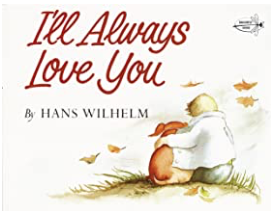
Anyone who knows me, knows I just love dogs. I admit I prefer larger dogs. You know those huge, soppy hounds who just want cuddles and when they drape themselves across you make your legs go dead. But I won't say no to a cuddle to those little ones who weight almost nothing and give you the smallest doggy breathe lick on the end of your nose.
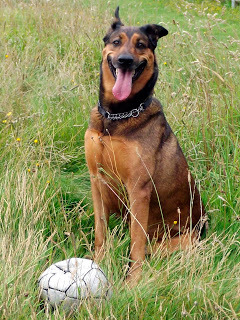 Tasha with one of her
Tasha with one of her
many found balls.
So, being a dog lover it's little wonder I'll Always Love You by Hans Wilhelm manages to bring a tear to my eyes when I read it. I always remember and reflect on the dogs I've love and lost, these being our Mitzi, Sally, Bonny, Jodi and Tasha. I remember with fondness their little quirks for example Jodi and her insistence on burying my underwear in the back garden (I hate to imagine what the neighbours thought) and Tasha with her ability to find a ball on our long walks in the local parks. And just like the family in the book I know I will always love each and every one of them, will always miss them but will also be lifted when I remember the adventures we enjoyed together.
Hoping your 2020 will provide you with many happy moments.
Jane Clarke chooses Jill Murphy's Five Minutes Peace
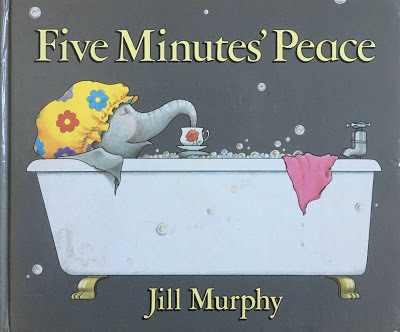
This book takes me back to a time in my life when I totally identified with Mrs Large's struggle to get five minutes peace. When I read it to my then small sons, they didn't get it at all. Now they are dads, they do - and my four granddaughters who fail to understand the concept. As the years go on, life changes. Now, I just LOVE it when my peace is shattered!
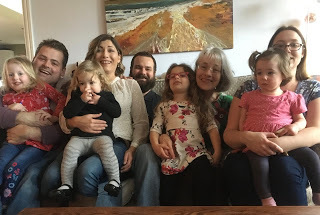
Warmest winter wishes. May 2020 be kind to you all. Jane x
Pippa Goodhart chooses Mr Gumpy's Outing by John Burningham
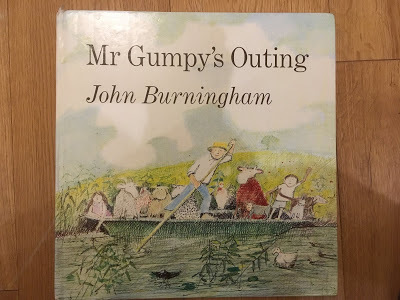
When my three daughters were little we shared this book over and over again. From the opening, 'This is Mr Gumpy' onwards, we loved it as more and more animals ask if they can join Mr Gumpy in his boat. The answer is always, 'Yes, if ...' you don't squabble or muck about or tease or chase or, actually all sorts of small naughtinesses that children themselves might do in a boat. And of course the animals DO all do those things, the boat tips over, 'and into the water they fell.' Drama! But not catastrophe. They walk home over the field to Mr Gumpy's house where 'it's time for tea.' Perfect!
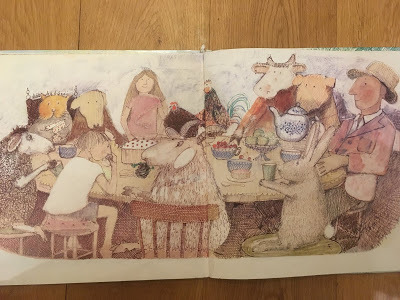
I've chosen this beautiful book both for the sentimental reason that it, with its battered spine and Sellotaped pages, brings back happy memories of when my children were 'children'. But also, of course, because wonderful John Burningham died this year ... but lives on for more and more children in his joyful books.
Very best wishes to all as the year, and the decade, give way to fresh ones. Pippa
Chitra Soundar chose Ocean Meets Sky by Eric Fan and Terry Fan
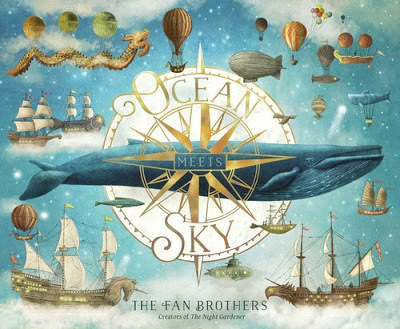
This summer I picked up this book from the Kate Greenaway Medal shortlist. It's a beautiful story of a boy coming to terms with his grandfather's passing. It was such a calming book to read, but it was also a time to reflect on what's happened and what's yet to happen.

The book has a magical quality to it because of both the words and the pictures. The images in the story inspired me to lay quiet and stare at the sky, watch cloud formations and understand how we are a small speck in this mighty universe. And there is a special place for all of us wherever our ocean will meet our sky.

I wish you all a wonderful celebration reflecting on the past year and welcoming the new one. May you all always find the time to imagine and discover magic in the clouds and on the waves. Chitra
Mini Grey chooses The Lost Words by Jackie Morris and Robert MacFarlane.

Another one from the Kate Greenaway shortlist that totally deservedly won. A book that's made an enormous impact and helped everyone to recognise that we love and need nature. Let's have this as a top priority in 2020. The book I want to get my sticky hands on this Christmas is Planetarium, words by Raman Prinja and incredible images by the wonderful Chris Wormell, printer and picture maker extraordinaire.
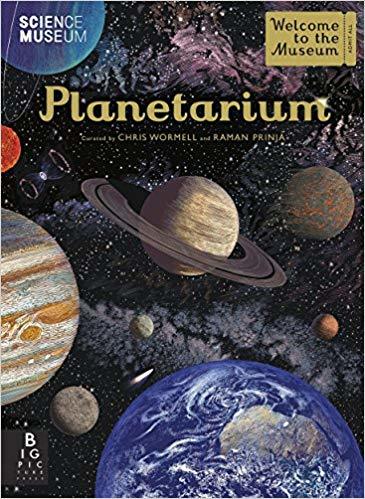
How brilliant to be able to take an entire universe out of your bookshelf whenever you need it.
Clare Helen Welsh chooses the ‘Mr. Men’ and ‘Little Miss’ books by Roger Hargreaves.At this time of year, families often get together and reminisce. In my case, the same old, embarrassing stories come out of the woodwork! Yes, I’m talking about the time I emptied talcum powder all over the bathroom and told my Nan, as white clouds billowed down the stairs, that I was making pastry!
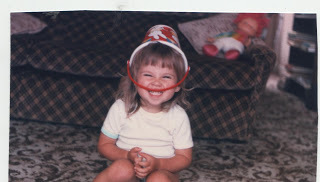 A cheeky younger me! I now see much of this mischievousness reflected in my favourite childhood books, including Burglar Bill by Janet and Allan Ahlberg and ‘Peepo’ by Janet and Allan Ahlberg. I also have very fond memories of the ‘Mr. Men’ and ‘Little Miss’ Books by Roger Hargreaves.
A cheeky younger me! I now see much of this mischievousness reflected in my favourite childhood books, including Burglar Bill by Janet and Allan Ahlberg and ‘Peepo’ by Janet and Allan Ahlberg. I also have very fond memories of the ‘Mr. Men’ and ‘Little Miss’ Books by Roger Hargreaves.

My Nan had a whole set of these books, and I would come back to them again and again and again. My favourite character? No, not Little Miss Trouble… Mr. Tickle, of course! I wonder if, like me, you'll find a correlation between the tales of younger you and your favourite books? I suppose what isn’t clear, is whether I was influenced by the books I read, or whether mischievous me was drawn to mischievous books. I suspect it’s the latter!
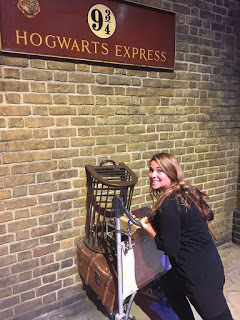 Thankfully, as a grown up, I am much more sensible!
Thankfully, as a grown up, I am much more sensible!
Wishing you health, happiness and much mischief in 2020. Clare
Lucy Rowland chooses 'The Jolly Postman' and 'The Jolly Christmas Postman' by Janet and Allan Ahlberg.
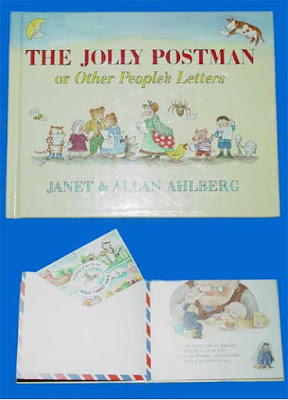
My sister and I used to LOVE 'The Jolly Postman'. Fairytale characters, a rhyming adventure, beautiful illustrations and, to top it all off, envelopes that you could open with real post inside!! We read it again and again. Later, of course, I also discovered the magic of The Jolly Christmas Postman, and it was just as exciting, if not more!
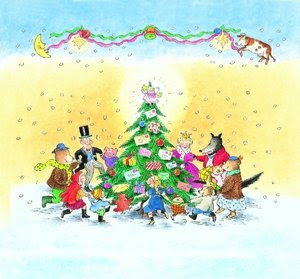
I love this time of year and I love Christmas, I always have. It's such a special time for me and I really enjoy thinking back to the Christmases we spent when I was young and the various Christmas traditions we had- the Christmas Eve party next door, the stockings hanging on the end of our beds, leaving out a mince pie for Father Christmas and a carrot for Rudolph....but this year I think is going to be my most special yet.
In September, we welcomed our baby boy into the world and it is our first Christmas as a family of three. I can't wait to share these books (and many many more) with Benji as he grows and to create new memories and holiday traditions of our own.
Wishing you all a very happy holiday season and lots of love and happiness in 2020. Lucy x
Garry Parsons chooses 'Me and My Fear' by Francesca Sanna and 'Julian Is A Mermaid' by Jessica Love.

Fear is a universal problem that affects everyone at some point in their lives, children and adults alike. Fear overwhelming our lives can often lead to enormous suffering and terrible consequences. Francesca Sanna's book gives us an image of fear that cleverly and simply describes the polarities of its grip, on the one hand appearing as friend and protector and on the other as oppressor and tyrant. Sanna then shows us subtly how to deal with it.
When I first read this book I was astounded. It's not only a poignant message for every human but it's beautifully illustrated. This book is a treasure and everyone should have a copy.

I am also choosing 'Julian Is A Mermaid' by Jessica Love. If you've had a tough day and you need to reconnect with what really matters in life then fall into this book for a dose of gentle acceptance and appreciation of human uniqueness. This book is about being free to be who you are, no matter who you are.
Merry Christmas!
The Picture Book Den team will resume posts in the new year.
We hope you enjoy and wish you a happy, healthy and prosperous 2020.
Lynne Garner chooses -
I Will Always Love You by Hans Wilhelm

Anyone who knows me, knows I just love dogs. I admit I prefer larger dogs. You know those huge, soppy hounds who just want cuddles and when they drape themselves across you make your legs go dead. But I won't say no to a cuddle to those little ones who weight almost nothing and give you the smallest doggy breathe lick on the end of your nose.
 Tasha with one of her
Tasha with one of hermany found balls.
So, being a dog lover it's little wonder I'll Always Love You by Hans Wilhelm manages to bring a tear to my eyes when I read it. I always remember and reflect on the dogs I've love and lost, these being our Mitzi, Sally, Bonny, Jodi and Tasha. I remember with fondness their little quirks for example Jodi and her insistence on burying my underwear in the back garden (I hate to imagine what the neighbours thought) and Tasha with her ability to find a ball on our long walks in the local parks. And just like the family in the book I know I will always love each and every one of them, will always miss them but will also be lifted when I remember the adventures we enjoyed together.
Hoping your 2020 will provide you with many happy moments.
Jane Clarke chooses Jill Murphy's Five Minutes Peace

This book takes me back to a time in my life when I totally identified with Mrs Large's struggle to get five minutes peace. When I read it to my then small sons, they didn't get it at all. Now they are dads, they do - and my four granddaughters who fail to understand the concept. As the years go on, life changes. Now, I just LOVE it when my peace is shattered!

Warmest winter wishes. May 2020 be kind to you all. Jane x
Pippa Goodhart chooses Mr Gumpy's Outing by John Burningham

When my three daughters were little we shared this book over and over again. From the opening, 'This is Mr Gumpy' onwards, we loved it as more and more animals ask if they can join Mr Gumpy in his boat. The answer is always, 'Yes, if ...' you don't squabble or muck about or tease or chase or, actually all sorts of small naughtinesses that children themselves might do in a boat. And of course the animals DO all do those things, the boat tips over, 'and into the water they fell.' Drama! But not catastrophe. They walk home over the field to Mr Gumpy's house where 'it's time for tea.' Perfect!

I've chosen this beautiful book both for the sentimental reason that it, with its battered spine and Sellotaped pages, brings back happy memories of when my children were 'children'. But also, of course, because wonderful John Burningham died this year ... but lives on for more and more children in his joyful books.
Very best wishes to all as the year, and the decade, give way to fresh ones. Pippa
Chitra Soundar chose Ocean Meets Sky by Eric Fan and Terry Fan

This summer I picked up this book from the Kate Greenaway Medal shortlist. It's a beautiful story of a boy coming to terms with his grandfather's passing. It was such a calming book to read, but it was also a time to reflect on what's happened and what's yet to happen.

The book has a magical quality to it because of both the words and the pictures. The images in the story inspired me to lay quiet and stare at the sky, watch cloud formations and understand how we are a small speck in this mighty universe. And there is a special place for all of us wherever our ocean will meet our sky.

I wish you all a wonderful celebration reflecting on the past year and welcoming the new one. May you all always find the time to imagine and discover magic in the clouds and on the waves. Chitra
Mini Grey chooses The Lost Words by Jackie Morris and Robert MacFarlane.

Another one from the Kate Greenaway shortlist that totally deservedly won. A book that's made an enormous impact and helped everyone to recognise that we love and need nature. Let's have this as a top priority in 2020. The book I want to get my sticky hands on this Christmas is Planetarium, words by Raman Prinja and incredible images by the wonderful Chris Wormell, printer and picture maker extraordinaire.

How brilliant to be able to take an entire universe out of your bookshelf whenever you need it.
Clare Helen Welsh chooses the ‘Mr. Men’ and ‘Little Miss’ books by Roger Hargreaves.At this time of year, families often get together and reminisce. In my case, the same old, embarrassing stories come out of the woodwork! Yes, I’m talking about the time I emptied talcum powder all over the bathroom and told my Nan, as white clouds billowed down the stairs, that I was making pastry!
 A cheeky younger me! I now see much of this mischievousness reflected in my favourite childhood books, including Burglar Bill by Janet and Allan Ahlberg and ‘Peepo’ by Janet and Allan Ahlberg. I also have very fond memories of the ‘Mr. Men’ and ‘Little Miss’ Books by Roger Hargreaves.
A cheeky younger me! I now see much of this mischievousness reflected in my favourite childhood books, including Burglar Bill by Janet and Allan Ahlberg and ‘Peepo’ by Janet and Allan Ahlberg. I also have very fond memories of the ‘Mr. Men’ and ‘Little Miss’ Books by Roger Hargreaves.

My Nan had a whole set of these books, and I would come back to them again and again and again. My favourite character? No, not Little Miss Trouble… Mr. Tickle, of course! I wonder if, like me, you'll find a correlation between the tales of younger you and your favourite books? I suppose what isn’t clear, is whether I was influenced by the books I read, or whether mischievous me was drawn to mischievous books. I suspect it’s the latter!
 Thankfully, as a grown up, I am much more sensible!
Thankfully, as a grown up, I am much more sensible! Wishing you health, happiness and much mischief in 2020. Clare
Lucy Rowland chooses 'The Jolly Postman' and 'The Jolly Christmas Postman' by Janet and Allan Ahlberg.

My sister and I used to LOVE 'The Jolly Postman'. Fairytale characters, a rhyming adventure, beautiful illustrations and, to top it all off, envelopes that you could open with real post inside!! We read it again and again. Later, of course, I also discovered the magic of The Jolly Christmas Postman, and it was just as exciting, if not more!

I love this time of year and I love Christmas, I always have. It's such a special time for me and I really enjoy thinking back to the Christmases we spent when I was young and the various Christmas traditions we had- the Christmas Eve party next door, the stockings hanging on the end of our beds, leaving out a mince pie for Father Christmas and a carrot for Rudolph....but this year I think is going to be my most special yet.
In September, we welcomed our baby boy into the world and it is our first Christmas as a family of three. I can't wait to share these books (and many many more) with Benji as he grows and to create new memories and holiday traditions of our own.
Wishing you all a very happy holiday season and lots of love and happiness in 2020. Lucy x
Garry Parsons chooses 'Me and My Fear' by Francesca Sanna and 'Julian Is A Mermaid' by Jessica Love.

Fear is a universal problem that affects everyone at some point in their lives, children and adults alike. Fear overwhelming our lives can often lead to enormous suffering and terrible consequences. Francesca Sanna's book gives us an image of fear that cleverly and simply describes the polarities of its grip, on the one hand appearing as friend and protector and on the other as oppressor and tyrant. Sanna then shows us subtly how to deal with it.
When I first read this book I was astounded. It's not only a poignant message for every human but it's beautifully illustrated. This book is a treasure and everyone should have a copy.

I am also choosing 'Julian Is A Mermaid' by Jessica Love. If you've had a tough day and you need to reconnect with what really matters in life then fall into this book for a dose of gentle acceptance and appreciation of human uniqueness. This book is about being free to be who you are, no matter who you are.
Merry Christmas!
The Picture Book Den team will resume posts in the new year.
Published on December 15, 2019 22:00
December 8, 2019
The Bookshelf of Life: How our Reading Journey Shapes Our Writing • by Natascha Biebow
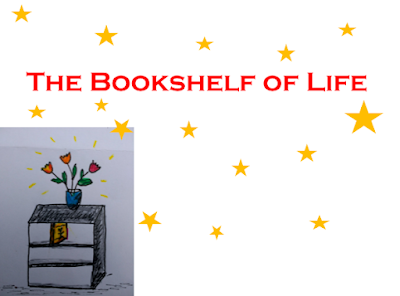
Stories are fluid, malleable creatures that shift with the teller, the listener and the place.
So what tales influence us? How does our journey and relationship with story influence the kind of reader we are, what kind of person, even, we become, and the kind of story we write, illustrate, edit and design?
I'd like to share with you a little about my bookshelf of life, in the hopes that it might encourage you to do the same. When I looked at it, I came away with a startling realization – books speak volumes about us . . . and our world views.
Today, there is a lot of talk about diversity, and the need to be inclusive, self-aware and open-minded in this challenging world in which we live. But equally, it can be frustrating the assumptions some people make when countenancing diversity. Diversity isn’t just the colour of the skin, gender or ethnicity.
 A selection of diverse picture books
A selection of diverse picture books Diversity runs much deeper than that. It is often unseen, complex, shaped by our experiences as children and adults, the places we’ve been (or not), our families, our interests and links to the outside world. All of us, we want to be seen, to be heard, to be respected for who we are, to be given opportunities and to be valued. We are all diverse in our own ways. And, if we can appreciate this, together we can be more.
So here are some of the books that tell you a little bit about me, that perhaps you might not have known before. They are stories I heard and the stories I read by myself that opened windows and doors and eyes and ears. And now the stories I write:
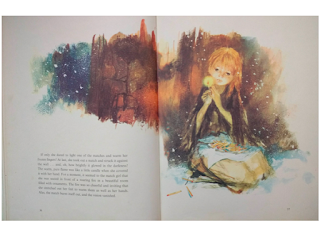 The Little Match Girl by Hans Christian Andersen from
The Little Match Girl by Hans Christian Andersen from Favourite Fairy Tales from Andersen illustrated by Paul Durand (Hamlyn) We didn’t have many picture books at home - possibly because we lived in Brazil, a non-English speaking country, and possibly because they were expensive and people just didn’t own such things? I had this beautiful anthology of Andersen Fairy tales and I made my mother read to me ‘The Little Match Girl’ even though it always made me cry. I’m not sure what my fascination with such a sad story was, but I see now that it is a story of light and hope for the little match girl warms her hands and her soul with images from her imagination.
My first grade teacher read CHARLOTTE’S WEB to us aloud. Every afternoon, the story would unfold. There is something gripping about being read to. Magical.
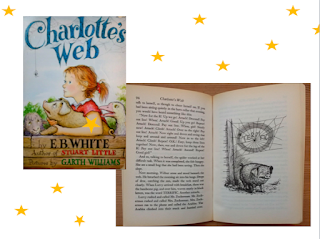 Charlotte's Web by EB White, illustrated by Garth WilliamsMy favourite place in the school was the library. There we had a giant papier-mache elephant in the central circular area, where the librarian read aloud after we chose our books during the weekly class visit.
Charlotte's Web by EB White, illustrated by Garth WilliamsMy favourite place in the school was the library. There we had a giant papier-mache elephant in the central circular area, where the librarian read aloud after we chose our books during the weekly class visit.
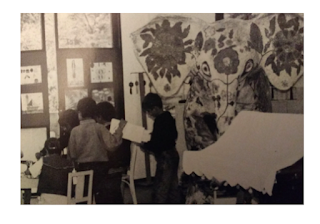 The Library where Reading became a joy and a habit
The Library where Reading became a joy and a habitI particularly remember this book, a Chinese folktale:
I read books in Portuguese too. This one – the story about family and big dreams – stuck with me. The main character is a girl who longs to be powerful and heard like grown-ups, boys and writers. Her dreams come to life in a series of characters stuffed into her precious yellow bag, including this feisty rooster.
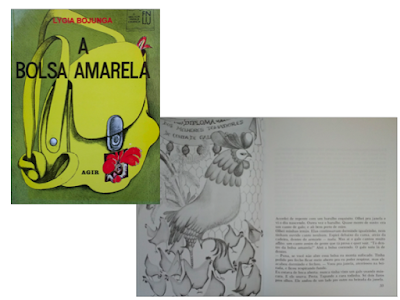 From A Bolsa Amarela by Lygia Bojunga
From A Bolsa Amarela by Lygia BojungaAlong with books from the library, the ones I owned were precious gifts sent by my grandmother, who lived in England. I read everything: horse and ballet books, fantasy, Pippi Longstocking, Paddington bear . . .
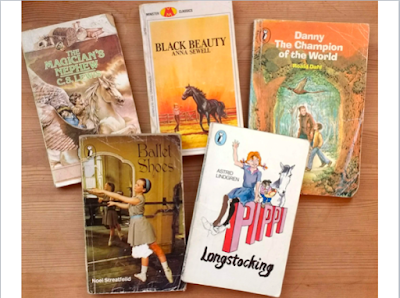
As well as many pivotal American authors (I went to an American school, though no one in my family is American), like Judy Blume and Beverly Cleary, who understood the ordinary child, the misfits, and captured the journey of figuring out who you are in this world. I still haven’t read the book about growing up with a disabled brother like mine; perhaps I need to write it someday.
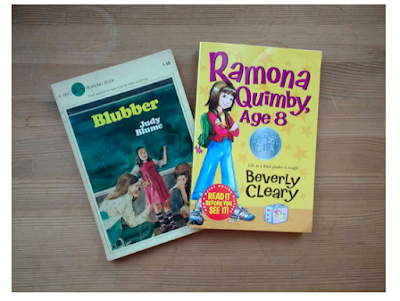
But the books that I was most drawn to were those with true story narratives. The stories of real people - the pioneers, the country vet, early people, the girl who survived with a pack of wolves, the writer - these are the ones that I was fascinated by and re-read countless times.
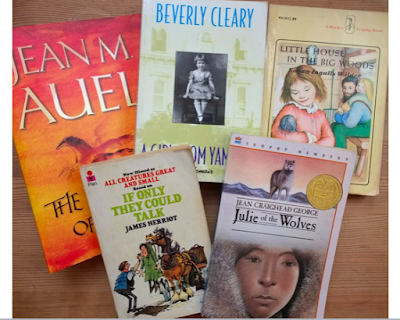
As I’ve mentioned, we didn’t have many picture books at home. Here is one that we didhave. I loved the detailed pictures and worlds.
 What Do People Do All Day? by Richard Scarry
What Do People Do All Day? by Richard ScarryLater, much later, at university, I started to discover the genre, which in the late 80s/early 90s was going through a boom. Since then, I’ve been lucky enough to edit and admire lots of picture books. Here are some of my favourites:
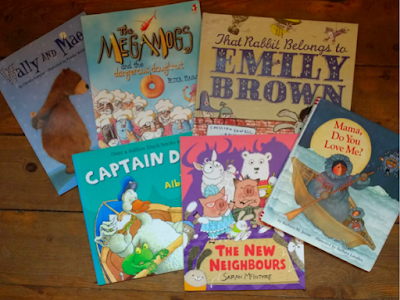
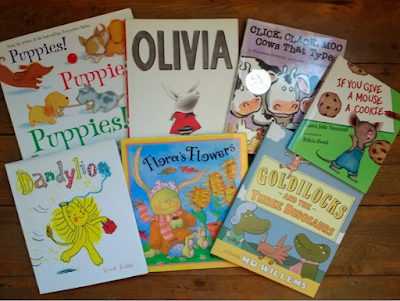
And even later, books that showed different kinds of families - ones that lived far-flung across the globe, and ones with disabled people in them and two mums and two dads.
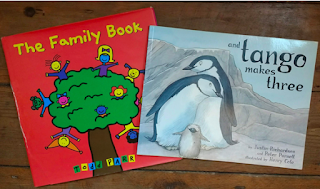
After a lot of exploration, I remembered that I liked true stories. As I child, I was fascinated by National Geographic WORLD magazine. I dreamt of becoming a writer for National Geographic. I found my calling as a children’s book editor and writer – I can’t get away from cool facts. I challenge myself – and you – to learn at least one new fact a day. It’s fun! And the truth is often stranger than fiction.
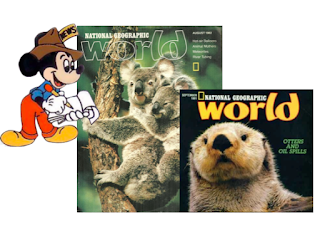 National Geographic World Magazine, published by National Geographic Like the story of this man, inventor Edwin Binney, who had a knack for listening and making what people needed and whose love of colour and nature
National Geographic World Magazine, published by National Geographic Like the story of this man, inventor Edwin Binney, who had a knack for listening and making what people needed and whose love of colour and nature 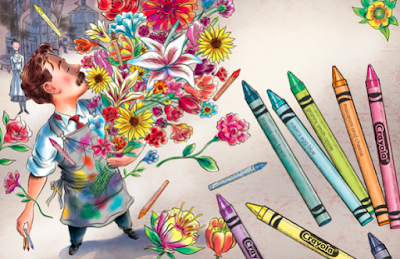 From The Crayon Man: The True Story of the Invention of Crayola Crayons
From The Crayon Man: The True Story of the Invention of Crayola Crayons by Natascha Biebow, illustrated by Steven Salernoled to the invention of Crayola crayons.
Whether the stories we read and tell are modern, mythical, magical, true or fictional – we want and need them to resonate, because then they ring true and, as such, they speak to us and our young readers. These are stories that inspire ideas, deal with fears, create a feeling of belonging, change preconceptions and so much more.
Only you have YOUR pocket full of diverse stories, your individual beat.
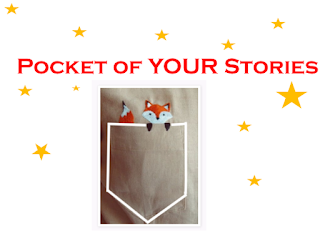
Trust it. Embrace the unknown, the strangeness. Sit with it. Discover your angels, your fears, your quirks.
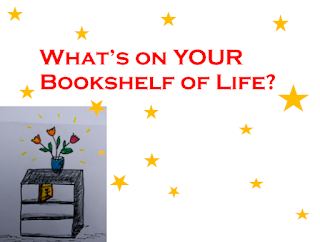
Published on December 08, 2019 20:00
December 1, 2019
An Interview with illustrator Anna Doherty, by Pippa Goodhart
I'm very proud to introduce illustrator Anna Doherty to the Picture Book Den. She illustrated by story 'Fair Shares' with wonderful colour and humour, clarity and beauty. Anna and I met this summer at the Edinburgh Book Festival, sharing doing an event based on 'Fair Shares'. She's lovely!So I've asked her a few questions -

- Were you a child drawn (sorry!) to drawing?I loved all sorts of creative things as a child. We always had an art project on the go, whether it was making seasonal decorations, toilet roll binoculars, presents, Christmas cards, or cardboard houses and teeny clay food for our Sylvanian Families.
We had a stack of continuous paper – A4 sheets all joined together in a concertina – and I would make books and magazines out of them.
I liked drawing pictures from books I was reading, and making huge illustrations of me and my friends on magical adventures, but I also liked drawing from real life too, like plants or flowers we had in the house.
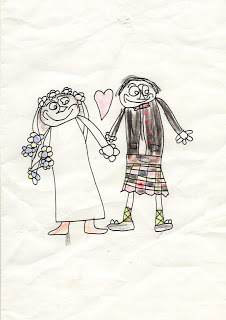
Anna's drawing, done aged five or six, of her parents', clearly very happy, wedding!
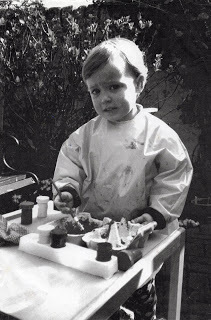
Little Anna, already painting, decorating an egg box.
- How did you train to become an illustrator? What is particular about illustration as an art form?I trained originally at Duncan of Jordanstone College of Art and Design in Dundee. I chose to go there because they had a foundation year where you could try out all the different art subjects before choosing which one to specialise in. I quickly discovered illustration was the one for me! We did a lot of quite varied projects, like ceramics, editorial work, screen printing, stage design, posters, which was amazing because we learnt illustration isn’t just one thing.
After I graduated, I decided I wanted to focus more on children’s books, so I went down to Cambridge School of Art and did a Children’s Book Illustration Masters.
That course set me up for the publishing world, and at the end we had a graduation show which lots of editors and art directors came to see, which is where I was lucky to meet my first publishers.
For me, the thing I love about illustration is that it’s so often narrative, and has a story to tell. I’ve loved books since I was very small, so illustrating them is a dream come true!

- Please tell us about your experience illustrating Fair Shares, illustrating somebody else’s story and words.Illustrating someone else’s text is exciting, because so often as an illustrator you are working at home alone, so it’s lovely to know someone else out there is sharing your experience.
Fair Shares was the first picture book which I’d illustrated someone else’s text rather than my own. Sometimes, illustrating a pre-existing text is more relaxing because the story is already there – but it can be challenging too, as I was very used to starting with character and building a plot around them rather than the other way around.
When I began to illustrate Fair Shares, Pippa had already more or less finished the text, so I had a clear outline of the story.
At the very beginning I was really nervous, always thinking, ‘what if this isn’t exactly what Pippa had in mind in this picture?’ so I loosened up by starting all the way from scratch and spending ages drawing bears and hares from real life, so I could learn the shape of the animals in different positions.

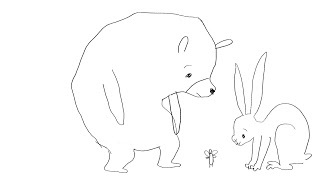
Once I’d drawn lots of bears and hares, they naturally began to turn into the characters who are in the book.
After I had the characters, I began layouts, thinking roughly how each page would be laid out.

I tried to have a mixture of full page and vignette, and of close up and far away illustrations, so that it’s interesting for the reader to look at. I drew ideas of what each page might look like very quickly and roughly, so there was lot of options, until I found the one that works best.
Then, it was time to draw the illustrations for real!
The very first page I drew was Bear reaching up high to try to grab some juicy pears. I originally drew it just to test out the colours and textures, but I liked it so much that it became a page in the book!
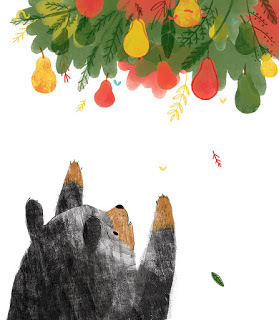
- What next for Anna Doherty, illustrator?!Lots, I hope! I’m working on some new idea nuggets at the moment, and I have the fourth book in my Fantastically Feminist series of non-fiction picture books about real life women coming out next year, which I’m very excited about!
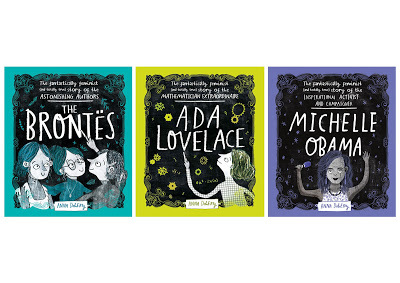
Thank you, Anna. Maybe we’ll work together on other books in the future? I hope so!

- Were you a child drawn (sorry!) to drawing?I loved all sorts of creative things as a child. We always had an art project on the go, whether it was making seasonal decorations, toilet roll binoculars, presents, Christmas cards, or cardboard houses and teeny clay food for our Sylvanian Families.
We had a stack of continuous paper – A4 sheets all joined together in a concertina – and I would make books and magazines out of them.
I liked drawing pictures from books I was reading, and making huge illustrations of me and my friends on magical adventures, but I also liked drawing from real life too, like plants or flowers we had in the house.

Anna's drawing, done aged five or six, of her parents', clearly very happy, wedding!

Little Anna, already painting, decorating an egg box.
- How did you train to become an illustrator? What is particular about illustration as an art form?I trained originally at Duncan of Jordanstone College of Art and Design in Dundee. I chose to go there because they had a foundation year where you could try out all the different art subjects before choosing which one to specialise in. I quickly discovered illustration was the one for me! We did a lot of quite varied projects, like ceramics, editorial work, screen printing, stage design, posters, which was amazing because we learnt illustration isn’t just one thing.
After I graduated, I decided I wanted to focus more on children’s books, so I went down to Cambridge School of Art and did a Children’s Book Illustration Masters.
That course set me up for the publishing world, and at the end we had a graduation show which lots of editors and art directors came to see, which is where I was lucky to meet my first publishers.
For me, the thing I love about illustration is that it’s so often narrative, and has a story to tell. I’ve loved books since I was very small, so illustrating them is a dream come true!

- Please tell us about your experience illustrating Fair Shares, illustrating somebody else’s story and words.Illustrating someone else’s text is exciting, because so often as an illustrator you are working at home alone, so it’s lovely to know someone else out there is sharing your experience.
Fair Shares was the first picture book which I’d illustrated someone else’s text rather than my own. Sometimes, illustrating a pre-existing text is more relaxing because the story is already there – but it can be challenging too, as I was very used to starting with character and building a plot around them rather than the other way around.
When I began to illustrate Fair Shares, Pippa had already more or less finished the text, so I had a clear outline of the story.
At the very beginning I was really nervous, always thinking, ‘what if this isn’t exactly what Pippa had in mind in this picture?’ so I loosened up by starting all the way from scratch and spending ages drawing bears and hares from real life, so I could learn the shape of the animals in different positions.


Once I’d drawn lots of bears and hares, they naturally began to turn into the characters who are in the book.
After I had the characters, I began layouts, thinking roughly how each page would be laid out.

I tried to have a mixture of full page and vignette, and of close up and far away illustrations, so that it’s interesting for the reader to look at. I drew ideas of what each page might look like very quickly and roughly, so there was lot of options, until I found the one that works best.
Then, it was time to draw the illustrations for real!
The very first page I drew was Bear reaching up high to try to grab some juicy pears. I originally drew it just to test out the colours and textures, but I liked it so much that it became a page in the book!

- What next for Anna Doherty, illustrator?!Lots, I hope! I’m working on some new idea nuggets at the moment, and I have the fourth book in my Fantastically Feminist series of non-fiction picture books about real life women coming out next year, which I’m very excited about!

Thank you, Anna. Maybe we’ll work together on other books in the future? I hope so!
Published on December 01, 2019 16:30
November 24, 2019
Eight Tips for Being a Great Guest Blogger • Lynne Garner
A few months ago the talented Moira Butterfield wrote a fab post for us (Tips on writing picture book non-fiction). Now, I've supported a lot of guest bloggers over the last eight years (eight years - where has that time gone?) as part of the Picture Book Den team by posting their content. Sometimes this has been a nightmare. The content I've received needed so much work that it took a lot of work to upload, format and check. However, being the pro that she is Moira's post took less than ten minutes to load, format and check. As soon as I received the content I knew I had to use my experience as a basis for this months post. I'll admit I have also used as my July (8th) post on Authors Electric.
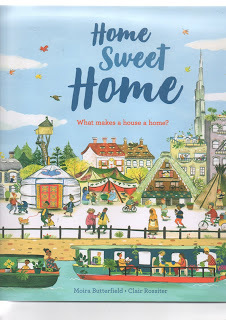 One of Moira's many non-fiction books
One of Moira's many non-fiction books
So, what follows are the things Moira got right plus a few things other guest writers got right.
Tip one:
First and foremost send your content in plenty of time. Everyone I know leads a busy life and there's nothing worse than receiving content the day before it's supposed to go live. It adds to the stress of everyday life and means there is no time to resolve a problems or ask any questions.
Tip two:
Send everything in one folder giving documents and images simple names e.g. blog, picture 1, picture 2 etc.
Tip three:
Send the text as a word document. Do not format it. If you include formatting it can cause issues. It's therefore easier for the person uploading the post to format as they go, rather than spend time fixing the issues caused by the formatting in the first place. If you want formatting e.g. bullet points then add instructions in red.
Tip four:
Typically as a guest blogger you are introduced at the beginning of the post. If you want to make the life of the person uploading your post even easier then include your own introduction and ensure you write it in the third person.
Tip five:
Within the text state where you want any images to go and include captions if you want some added. For example "image one here - with the following caption........." To make it clear they are instructions make them red.
Tip six:
If you want internal links to be included then provide these either at the bottom of the main post or as a separate document with an appropriate name.
Tip seven:
Don't forget to help your post be found 'labels' can be added in the post settings. So, if you can think of any labels that will drive traffic to your post then include them. This can be at the bottom of the main post content (remember to label them) or as a separate document in the folder (again with a file name that makes sense).
Tip eight:
Don't write a post that just sells your latest book. Give readers information, advice, share something of interest. It's fine to include an image from your book or the front cover as long as it supports the information/advice you are sharing. Alternately do as I do and place a plug at the end of your post, once the reader has learned something from you post. It also gives the reader the opportunity to follow to the links to your books or ignore.
If you have any other tips on how to be the best guest blogger please share in the comments section.
Last but not least - Moira Butterfield - thank you for giving me the idea for this post.
Blatant plug time
 Love a short story?
Love a short story?
Then check out my short story collections (available as ebooks and paperback):
Hedgehog of Moon Meadow Farm (ebook 99p/99¢ - 10 stories)
Fox of Moon Meadow Farm (ebook 99p/99¢ - 10 stories)
Ten Tales of Brer Rabbit (ebook 99p/99¢ - 10 stories)
Ten Tales of Coyote (ebook 99p/99¢ - 10 stories)
Anansi The Trickster Spider (ebook £1.49/$1.49 - 16 stories)
 One of Moira's many non-fiction books
One of Moira's many non-fiction booksSo, what follows are the things Moira got right plus a few things other guest writers got right.
Tip one:
First and foremost send your content in plenty of time. Everyone I know leads a busy life and there's nothing worse than receiving content the day before it's supposed to go live. It adds to the stress of everyday life and means there is no time to resolve a problems or ask any questions.
Tip two:
Send everything in one folder giving documents and images simple names e.g. blog, picture 1, picture 2 etc.
Tip three:
Send the text as a word document. Do not format it. If you include formatting it can cause issues. It's therefore easier for the person uploading the post to format as they go, rather than spend time fixing the issues caused by the formatting in the first place. If you want formatting e.g. bullet points then add instructions in red.
Tip four:
Typically as a guest blogger you are introduced at the beginning of the post. If you want to make the life of the person uploading your post even easier then include your own introduction and ensure you write it in the third person.
Tip five:
Within the text state where you want any images to go and include captions if you want some added. For example "image one here - with the following caption........." To make it clear they are instructions make them red.
Tip six:
If you want internal links to be included then provide these either at the bottom of the main post or as a separate document with an appropriate name.
Tip seven:
Don't forget to help your post be found 'labels' can be added in the post settings. So, if you can think of any labels that will drive traffic to your post then include them. This can be at the bottom of the main post content (remember to label them) or as a separate document in the folder (again with a file name that makes sense).
Tip eight:
Don't write a post that just sells your latest book. Give readers information, advice, share something of interest. It's fine to include an image from your book or the front cover as long as it supports the information/advice you are sharing. Alternately do as I do and place a plug at the end of your post, once the reader has learned something from you post. It also gives the reader the opportunity to follow to the links to your books or ignore.
If you have any other tips on how to be the best guest blogger please share in the comments section.
Last but not least - Moira Butterfield - thank you for giving me the idea for this post.
Blatant plug time
 Love a short story?
Love a short story? Then check out my short story collections (available as ebooks and paperback):
Hedgehog of Moon Meadow Farm (ebook 99p/99¢ - 10 stories)
Fox of Moon Meadow Farm (ebook 99p/99¢ - 10 stories)
Ten Tales of Brer Rabbit (ebook 99p/99¢ - 10 stories)
Ten Tales of Coyote (ebook 99p/99¢ - 10 stories)
Anansi The Trickster Spider (ebook £1.49/$1.49 - 16 stories)
Published on November 24, 2019 23:00
November 17, 2019
How 'I am a Tiger' became a series- guest post by Karl Newson
This week, I am delighted to welcome to the Picture Book Den the wonderful and incredibly talented Karl Newson- picture book author and illustrator extraordinaire!
How 'I Am a Tiger' became a Series
I didn’t set out to write a series. And Macmillan (my publisher) didn’t ask for one. Luckily for me, it happened accidentally…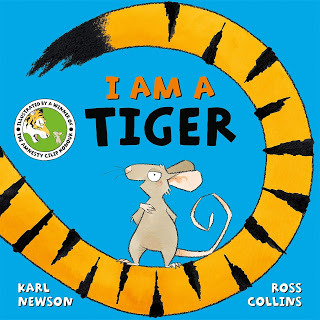
I Am a Tiger was written in the summer of 2016 (which seems like an age ago now!) during a head-scratching session in which I thought ‘Why isn’t there a character who declares confidently that it IS what it clearly is NOT?’ A simple idea that grew legs and whiskers and then took over. I knew the ‘IS what it ISN’T’ comparison had to be something ridiculous - something small being something big or vice versa - and a mouse was the obvious choice for the smallside of the story. I thought the text would be best delivered in dialogue, to show off mouse’s confidence (she is in charge here, there’s no narrator required to tell her story), and once mouse’s voice showed itself, the story pretty much wrote itself: I knew we’d need some opposition to mouse’s claims and that she should shake off their protests with seemingly easy but unexpected explanations; I knew at some point she would have to face the very thing she says she IS and that the two characters side by side would be a powerful image and text combination that would create a tense moment, perfect for being smashed with humour – with mouse’s witty retorts and clever thinking; and I knew that it would be wrong to just leave it as that, with all being exactly as mouse had said it was… it would be a rather flat ending wouldn’t it? There had to be a twist! It was right in front of my nose... the twist was a complete spin on the very words mouse had repeated the whole way through the story. Really, it was just one thought leading into another that took no more than 4 pages of my notebook and an afternoon’s scribbling. Really-Really, though, mouse wrote it all for me and it probably took years of thunks to think it up.
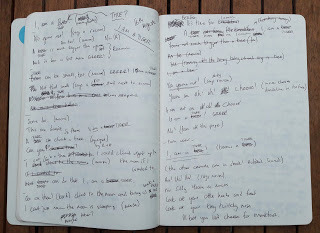
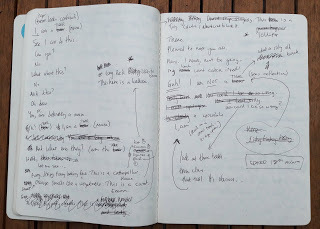
 The ‘big’ side of the story was initially going to be a bear, but because I already had two bear picture book stories in the making, my agent (Jodie Hodges) suggested we use a tiger instead. It gave the book that extra bit of GRRR! it needed.
The ‘big’ side of the story was initially going to be a bear, but because I already had two bear picture book stories in the making, my agent (Jodie Hodges) suggested we use a tiger instead. It gave the book that extra bit of GRRR! it needed.
When Macmillan offered to publish it, I was absolutely delighted! When they said Ross Collins would be illustrating it I let out a big excited ‘EEK’! And when I first visited my publisher and editor,
Penny, and the books designer, Kerrie, I knew this book was going to be something special. Together with Ross, they, and the whole team at Macmillan, took that little mouse and made it shine. And it was around this time that I discovered Mouse wasn’t done with me yet…
A simple idea fell into my notebook about rhyming ‘roar’ with ‘dinosaur’. It’s a well-worn and obvious rhyme, I know, but I went with it to see where it took me. It had all the right whatnots for a picture book and it had a fun title, but I slowly began to realise I knew this character’s voice already… it was way too close to the feel of I Am a Tiger. I was annoyed at myself, at first, for wasting a good idea on something that I couldn’t use (I couldn’t pitch a story similar to one I already had under contract, of course), but it felt too good to scrap, so I went with it... I let the main character BE the mouse it wanted to be and then I scribbled it all out again, in her voice. And it worked. But I was stuck. I had a story that I hadn’t intended to write and that could only ever be sent to one publisher. And to make it worse I was brand new to them and my only contracted book was still in the early stages itself… they hadn’t asked for a sequel at all. I Am a Tiger wasn’t due out for months yet so I couldn’t even use hopeful sales figures as a cheeky ‘Would you like to do a sequel?’ incentive. It was either I send it as an uninvited pitch or I leave it in my head for a while and maybe bring it out again once Tiger was out and getting feedback. I was worried it wasn’t author etiquette to send emails about sequels so soon into a contract. But I couldn’t help thinking that if I sat on it and then discovered at some point that a sequel might well be an option, then I’d have lost all that time (and possibly the buzz for it too). So I had a biscuit and sent it to Penny at Macmillan with a note saying ‘I know you haven’t asked for this and I feel really cheeky in putting it in front of you but it just sort of happened and I don’t know what else to do with it’.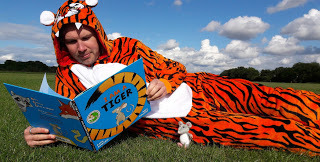
To my utter relief Penny liked the idea for the story, and to my surprise I was offered a new two book contract with the intension to write a third mouse story. I snapped it up, of course! (I was the crocodile, that day).
Mouse was now free. She had officially taken over. And her next idea was to make that accidentalsequel I had just written into the thirdbook in the series, and write another one to join the two together to make a linear threesome. So we did.
Having never before written a series I had no idea of the rules I had already put into place inside the text of the first story… rules that would now have to be applied to all three stories! This, in a good way, gave each one a structure that I could follow. But I definitely felt the pressure to make each one be better than the last. It had to have the same feel, but be a little bit different – a little bit more extreme, maybe, in mouse’s mousey-ness, and be funnier, too. I’m not allowed to give too much away because only I Am a Tiger is published as of the time I’m writing this, but I’ll try to go into a bit more detail on how the next books came to be…
First, book three, the original sequel (a line that makes it clear this is being written by Mouse!). In book one (I Am a Tiger), Mouse simply shrugs off the other animals with silly but simple points and carries on regardless, before dealing with the tiger in a similar fashion and then declaring them all to be something they didn’t know they are – a distraction for a get-away. In book two, this had to happen too, but in a bigger and better way. It needed an edge. (Just to confuse things, remember book two eventually became book three, so I’m talking about a story that’s not been announced yet anywhere). The main hook this story had was in its title. And so it became an action filled book. A guide, of sorts. An interactive read-along. But now this was to be book three and I didn’t have long to write a new sequel to fill the gap as the slot for Ross to begin the artwork was fast approaching. I had book ends, of a sort. Each true to mouse, but still being different to each other. The third story I would write –the second to be published – had to sit comfortably in between the two, without treading on eithers toes, and without out-shining them, but had to be a gradual step up from I Am a Tiger and a lead into the third story. This one did prove quite difficult, even for mouse.
The first story was a show of confidence. The third was an all-singing all-dancing interactive read, the second then - it seemed to me - had to be half way there. A bit of singing, maybe. And the idea for it came from a t-shirt I’d made for an event I was doing at Latitude. My shirt combined two of my stories – A Bear is a Bear (except when he’s not)(illustrated by Anuska Allepuz) and Here Comes the Sun (illustrated by Migy Blanco) both published by Nosy Crow. It combined the two main characters in those stories, an owl and a bear, in a simple play on words: ‘GROWL LIKE AN OWL’ (the site team at Latitude found it to be quite a weird thing to have on a t-shirt (I’d written it on in a sharpie) and they heckled me about it on my way in and out!). It was worth it though, as those words became the basis for story I needed.
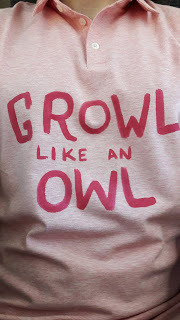
I followed the same train of thought I had when writing I Am a Tiger, letting the mouse take it for a walk, it soon became apparent that this wasn’t the start point, but more of a middle, so I ended up writing to the end first, then going back to the start to finish it off. It was a tricky one to get right! I sent it off to Macmillan and kept all my whiskers crossed, and Phew! it was accepted. Together we worked on making it as strong as we could (that’s Penny, Ross and Becky, the designer for this book and me), and I hope it will be a pleasing follow up to I Am a Tiger.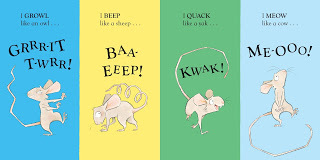
Its title is I Am NOT an Elephant (a spin on the theme of book one) and it publishes on 6th February 2020. I can’t wait!
Book three in the series publishes in October 2020 (Ross is working on the final artwork for it now, and, having had a peek, I can say it’s even better looking than the first two stories. What he does with characters is amazing! The guy is a genius.
I got incredibly lucky with these three stories, in finding the mouse character, having an agent who knew how to make it stronger, having a superb team behind me at Macmillan and of course being teamed up with Ross Collins. I am a little mouse in their shadows. A little mouse who is currently waiting to hear about Mouse’s next big idea… whiskers crossed!
Big thanks to Picture Book Den for allowing me to squeak on for all this time. And to everyone who has bought I Am a Tiger or any of my stories – thank you for your support!
Best whiskers!
Karl Newson
How 'I Am a Tiger' became a Series
I didn’t set out to write a series. And Macmillan (my publisher) didn’t ask for one. Luckily for me, it happened accidentally…

I Am a Tiger was written in the summer of 2016 (which seems like an age ago now!) during a head-scratching session in which I thought ‘Why isn’t there a character who declares confidently that it IS what it clearly is NOT?’ A simple idea that grew legs and whiskers and then took over. I knew the ‘IS what it ISN’T’ comparison had to be something ridiculous - something small being something big or vice versa - and a mouse was the obvious choice for the smallside of the story. I thought the text would be best delivered in dialogue, to show off mouse’s confidence (she is in charge here, there’s no narrator required to tell her story), and once mouse’s voice showed itself, the story pretty much wrote itself: I knew we’d need some opposition to mouse’s claims and that she should shake off their protests with seemingly easy but unexpected explanations; I knew at some point she would have to face the very thing she says she IS and that the two characters side by side would be a powerful image and text combination that would create a tense moment, perfect for being smashed with humour – with mouse’s witty retorts and clever thinking; and I knew that it would be wrong to just leave it as that, with all being exactly as mouse had said it was… it would be a rather flat ending wouldn’t it? There had to be a twist! It was right in front of my nose... the twist was a complete spin on the very words mouse had repeated the whole way through the story. Really, it was just one thought leading into another that took no more than 4 pages of my notebook and an afternoon’s scribbling. Really-Really, though, mouse wrote it all for me and it probably took years of thunks to think it up.


 The ‘big’ side of the story was initially going to be a bear, but because I already had two bear picture book stories in the making, my agent (Jodie Hodges) suggested we use a tiger instead. It gave the book that extra bit of GRRR! it needed.
The ‘big’ side of the story was initially going to be a bear, but because I already had two bear picture book stories in the making, my agent (Jodie Hodges) suggested we use a tiger instead. It gave the book that extra bit of GRRR! it needed.When Macmillan offered to publish it, I was absolutely delighted! When they said Ross Collins would be illustrating it I let out a big excited ‘EEK’! And when I first visited my publisher and editor,
Penny, and the books designer, Kerrie, I knew this book was going to be something special. Together with Ross, they, and the whole team at Macmillan, took that little mouse and made it shine. And it was around this time that I discovered Mouse wasn’t done with me yet…
A simple idea fell into my notebook about rhyming ‘roar’ with ‘dinosaur’. It’s a well-worn and obvious rhyme, I know, but I went with it to see where it took me. It had all the right whatnots for a picture book and it had a fun title, but I slowly began to realise I knew this character’s voice already… it was way too close to the feel of I Am a Tiger. I was annoyed at myself, at first, for wasting a good idea on something that I couldn’t use (I couldn’t pitch a story similar to one I already had under contract, of course), but it felt too good to scrap, so I went with it... I let the main character BE the mouse it wanted to be and then I scribbled it all out again, in her voice. And it worked. But I was stuck. I had a story that I hadn’t intended to write and that could only ever be sent to one publisher. And to make it worse I was brand new to them and my only contracted book was still in the early stages itself… they hadn’t asked for a sequel at all. I Am a Tiger wasn’t due out for months yet so I couldn’t even use hopeful sales figures as a cheeky ‘Would you like to do a sequel?’ incentive. It was either I send it as an uninvited pitch or I leave it in my head for a while and maybe bring it out again once Tiger was out and getting feedback. I was worried it wasn’t author etiquette to send emails about sequels so soon into a contract. But I couldn’t help thinking that if I sat on it and then discovered at some point that a sequel might well be an option, then I’d have lost all that time (and possibly the buzz for it too). So I had a biscuit and sent it to Penny at Macmillan with a note saying ‘I know you haven’t asked for this and I feel really cheeky in putting it in front of you but it just sort of happened and I don’t know what else to do with it’.

To my utter relief Penny liked the idea for the story, and to my surprise I was offered a new two book contract with the intension to write a third mouse story. I snapped it up, of course! (I was the crocodile, that day).
Mouse was now free. She had officially taken over. And her next idea was to make that accidentalsequel I had just written into the thirdbook in the series, and write another one to join the two together to make a linear threesome. So we did.
Having never before written a series I had no idea of the rules I had already put into place inside the text of the first story… rules that would now have to be applied to all three stories! This, in a good way, gave each one a structure that I could follow. But I definitely felt the pressure to make each one be better than the last. It had to have the same feel, but be a little bit different – a little bit more extreme, maybe, in mouse’s mousey-ness, and be funnier, too. I’m not allowed to give too much away because only I Am a Tiger is published as of the time I’m writing this, but I’ll try to go into a bit more detail on how the next books came to be…
First, book three, the original sequel (a line that makes it clear this is being written by Mouse!). In book one (I Am a Tiger), Mouse simply shrugs off the other animals with silly but simple points and carries on regardless, before dealing with the tiger in a similar fashion and then declaring them all to be something they didn’t know they are – a distraction for a get-away. In book two, this had to happen too, but in a bigger and better way. It needed an edge. (Just to confuse things, remember book two eventually became book three, so I’m talking about a story that’s not been announced yet anywhere). The main hook this story had was in its title. And so it became an action filled book. A guide, of sorts. An interactive read-along. But now this was to be book three and I didn’t have long to write a new sequel to fill the gap as the slot for Ross to begin the artwork was fast approaching. I had book ends, of a sort. Each true to mouse, but still being different to each other. The third story I would write –the second to be published – had to sit comfortably in between the two, without treading on eithers toes, and without out-shining them, but had to be a gradual step up from I Am a Tiger and a lead into the third story. This one did prove quite difficult, even for mouse.
The first story was a show of confidence. The third was an all-singing all-dancing interactive read, the second then - it seemed to me - had to be half way there. A bit of singing, maybe. And the idea for it came from a t-shirt I’d made for an event I was doing at Latitude. My shirt combined two of my stories – A Bear is a Bear (except when he’s not)(illustrated by Anuska Allepuz) and Here Comes the Sun (illustrated by Migy Blanco) both published by Nosy Crow. It combined the two main characters in those stories, an owl and a bear, in a simple play on words: ‘GROWL LIKE AN OWL’ (the site team at Latitude found it to be quite a weird thing to have on a t-shirt (I’d written it on in a sharpie) and they heckled me about it on my way in and out!). It was worth it though, as those words became the basis for story I needed.

I followed the same train of thought I had when writing I Am a Tiger, letting the mouse take it for a walk, it soon became apparent that this wasn’t the start point, but more of a middle, so I ended up writing to the end first, then going back to the start to finish it off. It was a tricky one to get right! I sent it off to Macmillan and kept all my whiskers crossed, and Phew! it was accepted. Together we worked on making it as strong as we could (that’s Penny, Ross and Becky, the designer for this book and me), and I hope it will be a pleasing follow up to I Am a Tiger.

Its title is I Am NOT an Elephant (a spin on the theme of book one) and it publishes on 6th February 2020. I can’t wait!
Book three in the series publishes in October 2020 (Ross is working on the final artwork for it now, and, having had a peek, I can say it’s even better looking than the first two stories. What he does with characters is amazing! The guy is a genius.
I got incredibly lucky with these three stories, in finding the mouse character, having an agent who knew how to make it stronger, having a superb team behind me at Macmillan and of course being teamed up with Ross Collins. I am a little mouse in their shadows. A little mouse who is currently waiting to hear about Mouse’s next big idea… whiskers crossed!
Big thanks to Picture Book Den for allowing me to squeak on for all this time. And to everyone who has bought I Am a Tiger or any of my stories – thank you for your support!
Best whiskers!
Karl Newson
Published on November 17, 2019 23:00
November 10, 2019
Writing a Bedtime Book by Abie Longstaff
My son was a brilliant sleeper. He was such a chilled baby that he could nap anywhere. I used to take him along to art classes in the pram, lay a coat over him and he’d soon be snoring. Then along came my daughter. She was a little ball of anxiety; colicky, wriggling, crying. She wanted constant back-patting, warm reassurance. And, no; she did not like going to sleep.
If I were placing a curse on my worst enemy, I would give them a baby who did not sleep. It’s a hidden problem – you drag yourself around like a zombie and no one knows quite how exhausted you feel: tired to your very bones. If you also have a toddler, add to this the need to be smiley and bouncy and present for your older child. Every day you hope this will be the night the little one sleeps, every evening you do all the right things – the bath, the calm singing, the back patting. But invariably your hopes are crushed as the second you sneak out of the room, the cries start up. It’s tough going. All you can do it ride it out.As my daughter grew, together we read a big pile of sleepy baby books. They brought great comfort: for me in knowing that mine wasn’t the only child who wanted to stay up and play; for her in seeing her behaviour mirrored in a picture book. She wasn’t naughty, she just wanted adventures or reassurance.We loved Goodnight Moon (Margaret Wise Brown), How do Dinosaurs say Goodnight (Jane Yolan and Mark Teague) and Dr Seuss’s Sleep Book, and our absolute favourite was The Baby Who Wouldn’t Go to Bed by Helen Cooper.
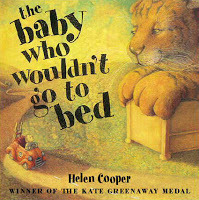
Of course, my own baby grew up. Then my sister called in a state of utter exhaustion – her little one wouldn’t sleep. It took me back to those tired days, and all the wonderful bedtime books. I decided to create something sleepy and soothing. The result was Who’s going to Bed? (illustrated by Eve Coy).So, how do you write a good bedtime book?Concept:Of course every picture book needs to be interesting and engaging, but there’s a fine line to walk here – don’t aim for too much excitement. You want to find a comfortable level: a bit of adventure, but in a familiar environment. Think of sleepy feelings: swinging, flying, floating, rocking and try to set your story around these. In Who’s Going to Bed, I chose familiar story characters – teddies, animals, pirates, knights - to create a comfortable, recognisable world.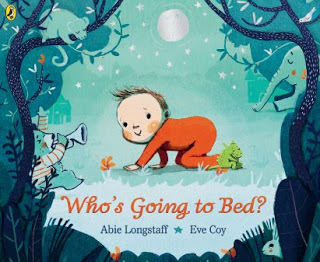
Text:You need to find a rhythm to your text, something almost lyrical to lull a child to sleep. Repetition, sibilant sounds, soft consonants, long vowels. I’ve included words like ‘sleep’, ‘yawn’, ‘shhhh’, ‘tired’; and increasing their frequency of use toward the end of the book.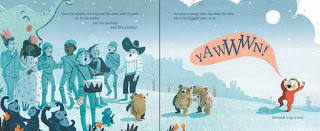
Pictures:Illustrator Eve Coy has used a limited palette of sleepy blues and greens – there are no loud, sharp colours here. She’s created something soft and gentle and magical.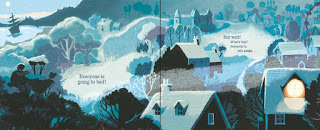
The End:With a bedtime book, you don’t want the end to be too funny or surprising. The aim is to settle and soothe. You want something safe – concepts like home, kiss goodnight, parents, duvet, bed, snuggling, cuddling. And if you can, try to bring the focus onto the reader, rather than the story characters.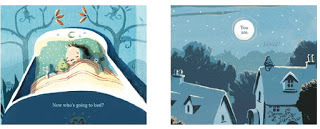
I’ve had lovely messages from parents saying their child is yawning at exactly the right moments! I hope the book brings comfort and pleasure. Most of all, I hope the book brings sleep.
Visit Abie's website to find out more about Abie and her wonderful books https://www.abielongstaff.com
If I were placing a curse on my worst enemy, I would give them a baby who did not sleep. It’s a hidden problem – you drag yourself around like a zombie and no one knows quite how exhausted you feel: tired to your very bones. If you also have a toddler, add to this the need to be smiley and bouncy and present for your older child. Every day you hope this will be the night the little one sleeps, every evening you do all the right things – the bath, the calm singing, the back patting. But invariably your hopes are crushed as the second you sneak out of the room, the cries start up. It’s tough going. All you can do it ride it out.As my daughter grew, together we read a big pile of sleepy baby books. They brought great comfort: for me in knowing that mine wasn’t the only child who wanted to stay up and play; for her in seeing her behaviour mirrored in a picture book. She wasn’t naughty, she just wanted adventures or reassurance.We loved Goodnight Moon (Margaret Wise Brown), How do Dinosaurs say Goodnight (Jane Yolan and Mark Teague) and Dr Seuss’s Sleep Book, and our absolute favourite was The Baby Who Wouldn’t Go to Bed by Helen Cooper.

Of course, my own baby grew up. Then my sister called in a state of utter exhaustion – her little one wouldn’t sleep. It took me back to those tired days, and all the wonderful bedtime books. I decided to create something sleepy and soothing. The result was Who’s going to Bed? (illustrated by Eve Coy).So, how do you write a good bedtime book?Concept:Of course every picture book needs to be interesting and engaging, but there’s a fine line to walk here – don’t aim for too much excitement. You want to find a comfortable level: a bit of adventure, but in a familiar environment. Think of sleepy feelings: swinging, flying, floating, rocking and try to set your story around these. In Who’s Going to Bed, I chose familiar story characters – teddies, animals, pirates, knights - to create a comfortable, recognisable world.

Text:You need to find a rhythm to your text, something almost lyrical to lull a child to sleep. Repetition, sibilant sounds, soft consonants, long vowels. I’ve included words like ‘sleep’, ‘yawn’, ‘shhhh’, ‘tired’; and increasing their frequency of use toward the end of the book.

Pictures:Illustrator Eve Coy has used a limited palette of sleepy blues and greens – there are no loud, sharp colours here. She’s created something soft and gentle and magical.

The End:With a bedtime book, you don’t want the end to be too funny or surprising. The aim is to settle and soothe. You want something safe – concepts like home, kiss goodnight, parents, duvet, bed, snuggling, cuddling. And if you can, try to bring the focus onto the reader, rather than the story characters.

I’ve had lovely messages from parents saying their child is yawning at exactly the right moments! I hope the book brings comfort and pleasure. Most of all, I hope the book brings sleep.
Visit Abie's website to find out more about Abie and her wonderful books https://www.abielongstaff.com
Published on November 10, 2019 22:00
October 28, 2019
Sketchbooking with Mini Grey
Sketchbooking

Here is my shelf with about 20 years of sketchbooks on it. If you count them you’ll see there’s only about one big one a year. But they are pretty full.In this post I’m going to look at all the different ways I use sketchbooks and the many different things a sketchbook can be.
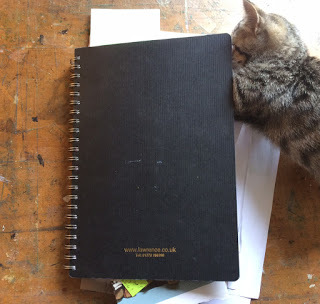 An example of Sketchbook One being investigated by a kitten
An example of Sketchbook One being investigated by a kittenSketchbook OneAt the moment I have about 4 different sizes of sketchbook I use most of the time. Sketchbook One is my main workbook. It’s spiral bound which means it can grow as more stuff gets stuck in, and it also lies flat. This sketchbook’s job is partly to be a bit like a box, a bit like a scrapbook.
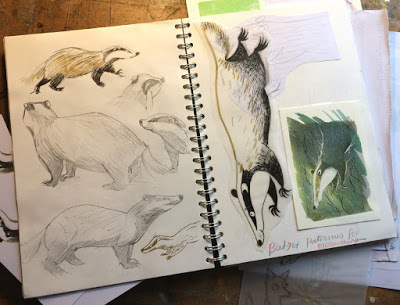 Badgery stuff for a Badger Patronus for Booktrust
Badgery stuff for a Badger Patronus for BooktrustPic of one bulging sketchbookIt has different areas. At the back is the zone for scribbled story ideas, for collected snippets, for useful bits & bobs, a place to collect material. Here are some interesting news snippets I found stored at the back in case they come in useful.
 Report of a suspicious smell haunting a German classroom
Report of a suspicious smell haunting a German classroom Cats vs mice at the British Museum
Cats vs mice at the British MuseumI return to the back - to find beginnings, take them into the main part of the next sketchbook and see if I can make something happen.
 From the back - the scribbled down beginnings of the Last Wolf
From the back - the scribbled down beginnings of the Last Wolf
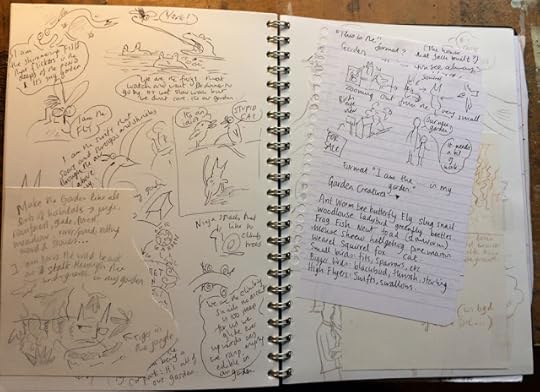 More from the back - ideas for a garden story (which never really worked.)
More from the back - ideas for a garden story (which never really worked.)Sketchbook One is also a reference library – some of the sketches from life I return to again and again.
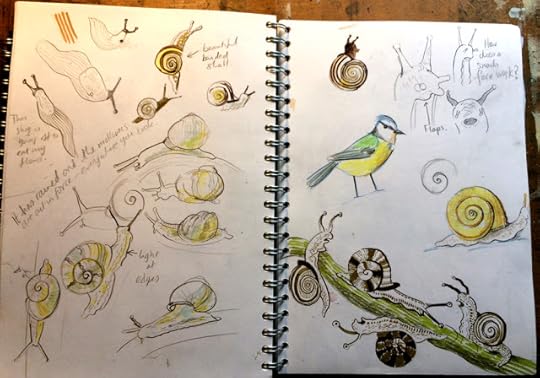 Snail Central down the bottom of the garden
Snail Central down the bottom of the garden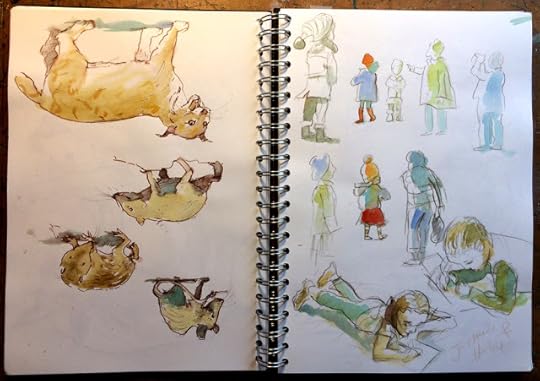 At the Natural History Museum
At the Natural History MuseumAlso this sketchbook is for collecting things that feel in the zone of your book. Here I am collecting my favourite tree illustrations when I was thinking about the last wolf.
 Trees by Emma Chichester Clark, Sara Ogilvy, Dave Barrow and David Litchfield
Trees by Emma Chichester Clark, Sara Ogilvy, Dave Barrow and David LitchfieldSketchbook One can also be a workshop or research lab for working things out: trying out character drawings,
 Drawings of Mrs Magpie for Money Go Round
Drawings of Mrs Magpie for Money Go Round
 Collecting the colours for Money Go Round
Collecting the colours for Money Go Round
 Trying to work out Walter Rat for Money Go Round
Trying to work out Walter Rat for Money Go Roundcollecting colour schemes, working out The Rules (every book should have some), trying some paper engineering, working out layouts, trying out colour sketches for spreads.
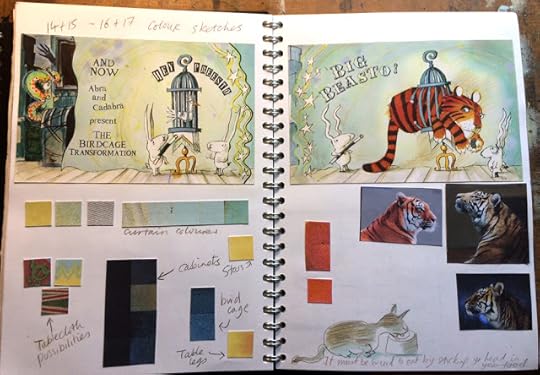 Colour sketches for The Bad Bunnies Magic Show
Colour sketches for The Bad Bunnies Magic Show Working out a recipe for Red in The Last Wolf
Working out a recipe for Red in The Last WolfSketchbook One is also a place for collecting responses, trying out a story splurge – responding to words with pictures or vice-versa; picture brainstorming on a theme.
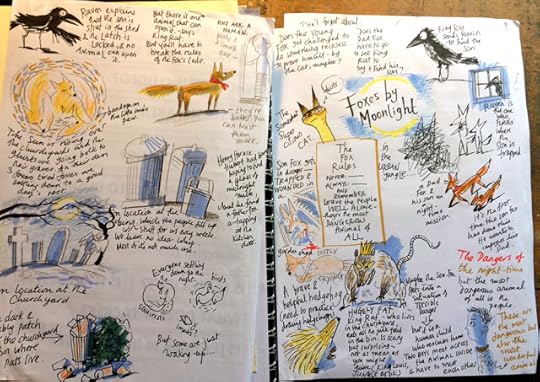 Collecting ideas about foxes
Collecting ideas about foxes Messing with a bit more colour and the foxes again
Messing with a bit more colour and the foxes againSometimes a way of collecting is drawing to find things out (draw to explore) Scrap paper is often better than a clean sheet.Sometimes it’s just drawing what’s just happened, as in this Goldfish Emergency.
 The very sad ends of Paul and Lewis
The very sad ends of Paul and LewisHere are drawings for things that ended up on my blog.
 Trouble at the Supermarket with Doris the Hen
Trouble at the Supermarket with Doris the Hen Doris discovers the truth about meat
Doris discovers the truth about meat Experimenting with the RestoftheWorldists
Experimenting with the RestoftheWorldistsAnd here’s my sketchbook from just a few days ago. You can see I’ve been trying to work out how to tackle ducks and kippers and making a puppet version of AF Harold.
 What are the rules?
What are the rules?
Sketchbook One usually stays in my studio. But on to more roving sketchbooks. Here are the Out & About Sketchbooks.
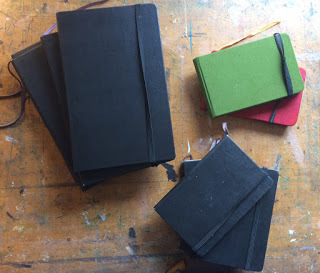
Out & About One: The MoleskineThe Moleskine: has a useful pocket and elastic.
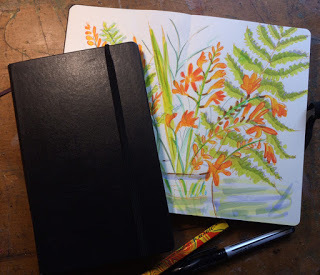
Here it is out & about at Oxford Natural History Museum, on holiday, at the zoo.
 Oxford Natural History Museum
Oxford Natural History Museum Oxford Natural History Museum
Oxford Natural History Museum Grant Museum of Zoology
Grant Museum of Zoology Acer in a garden
Acer in a gardenAlso, sometimes it is to be found taking notes at talks. Here are some of those:
 Katherine Heyhoe talks about Climate in Oxford
Katherine Heyhoe talks about Climate in Oxford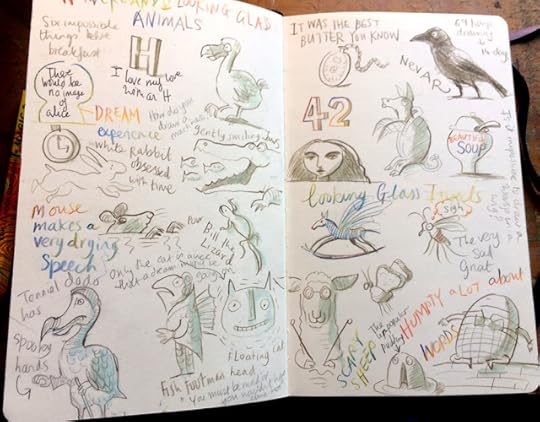 John Vernon Lord talking about Alice in Wonderlan
John Vernon Lord talking about Alice in Wonderlan  George Monbiot on Capitalism
George Monbiot on CapitalismBut I had repeated problems fitting giraffes into the Moleskine, especially the giraffe Skeleton at Oxford Natural History Museum.



Out & About Two: The Little Landscapey One
So here’s The Turner landscapey sketchbook: its interestingly narrow format forces unexpected things to happen. At last I can fit a giraffe in.

Looking at the contents, some themes emerge; Heads on Columns; Tall Gawky Birds; Drawing Trees when Waiting For Buses; Waiting at Stations in Paris, Pub Gardens.





Stranded in Paris I realised the power of sketching when you’re stuck or waiting – it’s a totally enthralling pursuit which makes time swim by.

 But also the process of looking is captivating. Drawing from life – changes your insight into what you are observing; paying attention to it means you will always notice it when you encounter it again.
But also the process of looking is captivating. Drawing from life – changes your insight into what you are observing; paying attention to it means you will always notice it when you encounter it again. Here are some anenomes and hydrangea – and I know that drawing them has made me feel a bond with anenomes and hydrangeas and notice them too.

Out & About Three: The Teeny One
Lastly, here is the Teeny Moleskine: it’s one with thin paper so there are lots of pages & it doesn’t matter if you use loads of it or it gets torn out. It’s always in my bag along with a black pen & a magic pencil.Sketching is a bit like hunting!!! It’s trying to capture something. (Often in restaurants bars and pubs I notice.) Here are people out at the Cazbar on the Cowley Road.

Drawing Together
The back of the Teeny Sketchbook is where Drawing Together happens. This usually happens as a thing to do in pubs and restaurants with Herbie (now 13). The rules of Drawing Together: Take turns. Each person tells the other person what to draw next. And you have to accept what you’re given. So to finish, a gallery of characters from Drawing Together with Herbie over the past year….
The Drawing Together Gallery
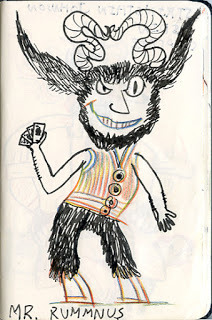 Mr Rumnus
Mr Rumnus
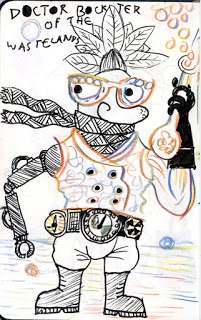 Doctor Bockter of the Wastelands
Doctor Bockter of the Wastelands
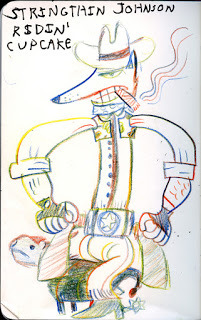 Stringthin Johnson ridin' Cupcake
Stringthin Johnson ridin' Cupcake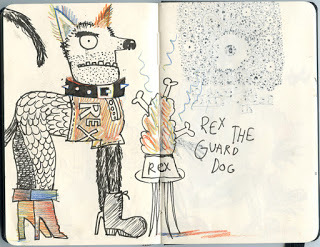 Rex the Guard Dog
Rex the Guard Dog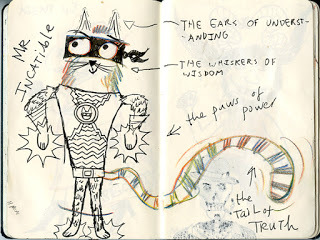 Mr Incatible
Mr Incatible
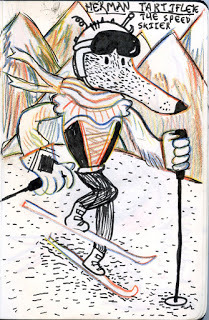 Herman Tartiflett the Speed Skier
Herman Tartiflett the Speed Skier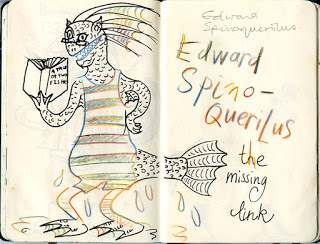 Edward Spinoquerilus
Edward Spinoquerilus...and I guess what this all ultimately shows is that: as a family, we spend an awfully large amount of time down the pub.
Mini Grey.
Click here to view Mini's blog, Sketching Weakly.
Published on October 28, 2019 02:42
October 20, 2019
Inspiration on the Internet by Chitra Soundar
When I’m bored, or tired or overwhelmed with deadlines, so basically when I have nothing to do or loads to do, I tend to nurture my muse. I leave my computer behind and sit in front of a notebook – preferably large and one with no lines. I bring all my colour-pens and pencils and start playing with the ideas in my head. The other thing I do to inspire my muse is to read about writing picture books. Much of the advice will overlap, sure! But in those corners of the Internet where other writers have hidden their wisdom, I sometimes find an idea I could use. Or even a new way to work. Or perhaps reassurance that my jumble of words will one day rearrange themselves into a masterpiece. The sure-fire way to get back to writing a new story, especially if words are not falling in the right order and everything seems clunky as a bronze bucket being dipped into a well, I read books – picture books, writing books and poetry books. Clever words in the right order help me un-jumble my brain too. So I thought I’d share some of my recent finds – some advice on writing picture books that might inspire you to write too. First, you’re already sitting on a gold-mine of picture book inspiration – here, this site – Picture Book Den is a good place to start. Here we have discussed anything from wasting time to writing the other. Casting the net a bit further from home, here are some other gems I found on the Internet.
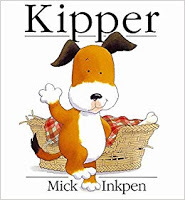 Mick Inkpen, the creator of Kipper has some wise words here.
Mick Inkpen, the creator of Kipper has some wise words here.Kate Wilson, MD of Nosy Crow books talks about rhyming picture books here.
David O’Connell talks about gives some great tips on writing and finishing that picture book in your head. Get it out all out. If you’re an illustrator, don’t forget to read Sarah McIntyre’s tips here too.
Listen to David and Sarah talking about their book Jampires.
Josh Funk, the American picture book writer gives his tips here in 12 lessons. You’re sorted for the next 12 weeks of funk.
Shoo Rayner gives advice to writers in this video.
And finally, Natascha Biebow, a Picture Book Denner and co-chair of SCBWI British Isles writes a regular column at Words & Pictures. Check out her informative posts here.
And if you're an illustrator, do check out the Illustrating Knowhow posts too.
So what are you waiting for? Browse these articles without guilt and I assure you, you'd be itching to write your own story soon. If you have a favourite article on writing or illustrating picture books, leave them in the comments section.
 Chitra Soundar is the author of over 30 books for children. Her latest picture books are You're Strong With Me, illustrated by Poonam Mistry, published by Lantana Publishing and Shubh Diwali! illustrated by Charlene Chua and published by Albert Whitman. Find out more at www.chitrasoundar.com and follow her @csoundar on Twitter.
Chitra Soundar is the author of over 30 books for children. Her latest picture books are You're Strong With Me, illustrated by Poonam Mistry, published by Lantana Publishing and Shubh Diwali! illustrated by Charlene Chua and published by Albert Whitman. Find out more at www.chitrasoundar.com and follow her @csoundar on Twitter.
Published on October 20, 2019 23:00



